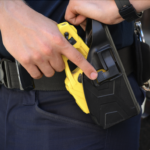People Shot Dead by Police in US, UK and Australia

A disturbing infographic depicts the number of people killed in the United States as a result of police shootings – a staggering 776 people have been shot dead by US police so far this year.
By contrast, the total in the United Kingdom is just one.
In Australia, there were 92 fatal police shootings between 1992 and 2011. While this pales in comparison with the US, it is still a significant figure for a country with strict gun laws and a tiny population.
The US population currently stands at 318 million – five times the size of the UK (64.1 million) and about thirteen times the size of Australia (23.1 million).
Given that both the UK and Australia have strict gun laws and a predominantly unarmed population, there is a strong argument that the rate of police shootings here should be much closer to the UK than the US.
Why do US Police Shoot So Many People?
The most obvious difference between the US on the one hand, and the UK and Australia on the other is gun control.
In America, citizens have a “right to bear arms” under the second amendment to the constitution.
In the case of District of Columbia et al v Heller (2008), the US Supreme Court confirmed that citizens have the right to own guns. Before that ruling, the US District of Columbia passed laws making it illegal to own a gun without a licence and registration. But a police officer challenged the law, saying he had a constitutional right to own a gun, even if it was unregistered and he was unlicensed. The court agreed with him.
But the fact that a large percentage of Americans own guns doesn’t change the fact that US police are only supposed to use deadly force when there is an immediate danger to their own lives, or the lives of others.
It is certainly true that US police may need to be more vigilant given that there is a good chance that the person they are facing is armed with a gun. But many recent incidents suggest that US police are using deadly force when there is no direct threat.
For example, a Wisconsin police officer fatally shot and killed an unarmed teenager in his own home in June of this year. And in Albuquerque, a mentally ill, homeless black man was recently shot dead, despite footage clearly showing that he was unarmed and posed no threat at all.
Thanks to social media, footage of such unjustified police shootings can be viewed by the public – which one would expect might make officers think twice before shooting people dead.
The UK: Unarmed General Police
The single fatal police shooting in the United Kingdom occurred last week in north London. British police shot James Fox, a 43 years old white man, after receiving reports that he was threatening to shoot another person. Police stormed Fox’s flat and shot him dead.
The UK’s previous police shooting was in Islington in September 2014, which occurred after a man threatened his ex-partner with a knife.
British general duties police officers are not armed with lethal weapons. They can call for back up if lethal force is required, and only senior officials have the power to authorise its use.
In the five years from 2008 to 2012, England and Wales had a total of 9 fatal police shootings.
Australia: How Do We Compare?
Comparatively, there were 14 fatal police shootings in Australia during the four years from 2008 to 2011, despite the fact that the UK has almost three-times our population.
Unlike the UK, general duties police officer in Australia are immediately armed with guns; despite their very limited general and firearms training.
So, is it time to restrict general duties police to non-lethal weaponry?
Are tasers, batons, pepper spray and handcuffs enough against a predominantly unarmed population?
Such restrictions were indeed implemented in Victoria, which in the 1980s and 1990s became notorious for unjustified shootings by police. The state started Project Beacon in 1994, and the number of police fatal shootings halved over the next 10 years.
But the powerful police association eventually got its way and police were re-equipped with guns, despite any evidence that lethal weaponry was required, or even desirable.
And in 2005, the lethal shooting of 15-year-old Tyler Cassidy in Northcote, Victoria prompted a further enquiry, which found that the police command failed to adequately train officers to deal with emotionally unstable people.
In NSW, the coroner was scathing of police for their disgraceful lethal shooting of 36-year-old Adam Salter in 2009, and the subsequent police cover-up. Salter was shot twice in the back at his father’s home in Lakemba despite posing no danger to police or anyone else. The coroner found that investigating police – including senior officers – then tried to cover-up the crime by lying in their statements, and then lying under oath to the Police Integrity Commission. Four officers were charged with perjury.
The message appears to be clear: Australian police are either inadequately trained in the use of firearms, or are willing to resort to lethal force without justification.
Either way, something needs to be done to prevent further unjustified police shootings. If police are to keep their guns, adequate training is needed to ensure that civilians are only shot dead in the right circumstances – and only as a last resort.
Alternatively, the UK approach of only equipping certain officers with lethal weaponry may ironically keep us all safer.






